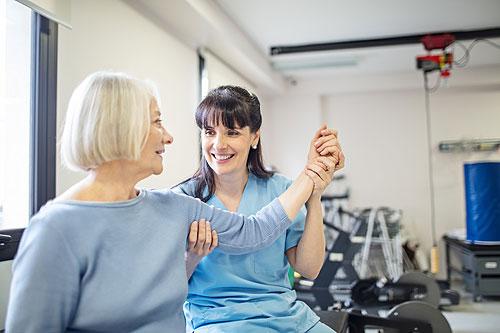Staying Active When You Have Arthritis

Many older adults who are living in a skilled nursing facility have arthritis. Over 25% of all older adults do. You might think that medications are the only treatment for arthritis, but that is actually only a small part of the help that is available. Today, fewer people with arthritis are taking the powerful opioid medications that were once routinely prescribed for pain. We now know that opioids aren’t as safe as once thought.
It’s good to know that there are many other ways to treat arthritis. Medication is only part of the picture. In fact, the best way to lessen the pain and stiffness of arthritis is exercise.
Not so many years ago there was a common belief that people with arthritis should take it easy. They were told to rest their joints and to avoid movements that might be painful.
We now know that this was very bad advice! Exercise is one of the best ways to lubricate the joints and keep them flexible, thereby lessening pain. Avoiding movement can lead to a downward cycle, in which a person with arthritis is afraid to move a painful joint … and the consequent immobility makes pain and stiffness all the worse.
Exercising also helps residents lose weight. Those extra pounds put a lot of strain on the joints, and studies show that losing even a little bit of weight can make a difference.
It can seem counterintuitive to move a painful hand, knee, shoulder or other joint. This is where nursing home staff can be so helpful. Did you know that anxiety increases the sensation of pain? Studies show that one of the best ways to make exercise more comfortable is to provide patients with the information they need to be confident they’re performing movements the correct way!
Before beginning an exercise plan, it’s important to get an individualized exercise “prescription” from the doctor. This will most likely include low-impact, joint-friendly activities from four main categories:
- range-of-motion exercises to improve flexibility and relieve stiffness
- strengthening exercises to help muscles support the joints
- balance exercises to reduce the risk of falls
- aerobic or endurance exercises to reduce swelling in some joints and help maintain a healthy weight
Walking is a great exercise for people with arthritis. If a resident is nervous about making their way around, having helpful staff on hand provides an extra measure of confidence. The same goes for exercise classes.
Rehabilitation department staff provide supervision during exercise, as well as other therapies, which might include body mechanics training, massage, heat and cold treatments, splinting or electrical nerve stimulation. The rehab department can also help patients and residents with the use of assistive devices such as walkers and canes. Used improperly, these devices can make a person less safe! But with training, residents can be much more independent using them.
The rehab staff can do much more. Patients and residents can learn to do things in a different way that overcomes their limitations. Can’t open that container? Try this handy jar opener! Is it hard to zip your dress or tie your shoes? There’s a gadget for those activities, too. Senior-friendly adaptations such as a raised toilet seat and grab bars help, as well. And to help residents avoid movements that are genuinely dangerous or unadvised, staff are there to lend a hand.
Skilled nursing facilities also prepare nutritious meals that support joint health, help residents manage their medications, and coordinate healthcare appointments. And if the doctor decides a joint replacement is in order, a skilled nursing facility is a great place to recover, receive therapy, and access all the resources a patient needs for the best possible success.
Source: IlluminAge Communication Partners; copyright 2019 IlluminAge
![Grace Barker Health [logo]](https://www.gracebarkerhealth.com/wp-content/themes/gracebarker-2017/images/logo.png)




